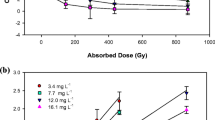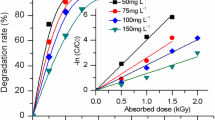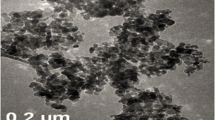Abstract
The impact of human activities in the past few decades has paved the way for the release of pollutants due to the improper effluent treatment. Recent studies revealed that, Ofloxacin, an antibiotic as one of the major pollutant affecting surface water and ground water. In this study, the radiolytic potential of Ofloxacin was investigated. The effects of pH, dose and concentration of Ofloxacin were analyzed using One Factor At a Time (OFAT) and the interactive effects between the parameters were studied using Face Centered Central Composite Design. The statistically optimised developed model shows 30% degradation at initial antibiotic concentration of 1mM at pH 3.0 and at 2 kGy dose of gamma ray. The process efficiency was evaluated in terms of G value and its correlation with the concentration of antibiotic was also established. The process of degradation was augmented by the addition of H2O2 (1.5 mM). The reaction kinetics for the process was evaluated, the dose rate constant and the rate of degradation for the augmented process was found to be 0.232 kGy-1 and 0.232 mM/kGy, respectively. The degraded metabolites of the radiolytic degradation of Ofloxacin were analyzed through change in pH, reduction in TOC and GC-MS spectrum.

Similar content being viewed by others
References
Basfar A A, Khan HM, Al-Shahrani A A, Cooper WJ (2005). Radiation induced decomposition of methyl tert-butyl ether in water in presence of chloroform: Kinetic modelling. Water Research, 39(10): 2085–2095
Biswal J, Paul J, Naik D, Sarkar S, Sabharwal S (2013). Radiolytic degradation of 4-nitrophenol in aqueous solutions: Pulse and steady state radiolysis study. Radiation Physics and Chemistry, 85: 161–166
Changotra R, Guin J P, Varshney L, Dhir A (2018a). Assessment of reaction intermediates of gamma radiation-induced degradation of ofloxacin in aqueous solution. Chemosphere, 208: 606–613
Changotra R, Guin J P, Varshney L, Dhir A (2018b). Assessment of reaction intermediates of gamma radiation-induced degradation of Ofloxacin in aqueous solution. Chemosphere
Cruz-González K, Torres-Lopez O, García-León A M, Brillas E, Hernández-Ramírez A, Peralta-Hernández J M (2012). Optimization of electro-Fenton/BDD process for decolorization of a model azo dye wastewater by means of response surface methodology. Desalination, 286: 63–68
Darvishi Cheshmeh Soltani R, Rezaee A, Khataee A, Godini H (2014). Optimisation of the operational parameters during a biological nitrification process using response surface methodology. Canadian Journal of Chemical Engineering, 92(1): 13–22
De Bel E, Janssen C, De Smet S, Van Langenhove H, Dewulf J (2011). Sonolysis of ciprofloxacin in aqueous solution: Influence of operational parameters. Ultrasonics Sonochemistry, 18(1): 184–189
de la Cruz F, Davies J (2000). Horizontal gene transfer and the origin of species: Lessons from bacteria. Trends in Microbiology, 8(3): 128–133
Golet E M, Alder A C, Hartmann A, Ternes T A, Giger W (2001). Trace determination of fluoroquinolone antibacterial agents in urban wastewater by solid-phase extraction and liquid chromatography with fluorescence detection. Analytical Chemistry, 73(15): 3632–3638
Grayson M L, Cosgrove S E, Crowe S, Hope W, Mccarthy J S, Mills J, Mouton J W, Paterson D L (2017). Kucers’ the Use of Antibiotics: A Clinical Review of Antibacterial, Antifungal, Antiparasitic, and Antiviral Drugs. Three Volume Set. Boca Raton: CRC Press
Hirsch R, Ternes T, Haberer K, Kratz K L (1999). Occurrence of antibiotics in the aquatic environment. Science of the Total Environment, 225(1-2): 109–118
Kanakaraju D, Glass B D, Oelgemöller M (2018). Advanced oxidation process-mediated removal of pharmaceuticals from water: A review. Journal of Environmental Management, 219: 189–207
Kidak R, Dogan S (2018). Medium-high frequency ultrasound and ozone based advanced oxidation for amoxicillin removal in water. Ultrasonics Sonochemistry, 40(Pt B): 131–139
Kümmerer K (2009). Antibiotics in the aquatic environment: A review—Part I. Chemosphere, 75(4): 417–434
Le-Minh N, Khan S J, Drewes J E, Stuetz RM (2010). Fate of antibiotics during municipal water recycling treatment processes. Water Research, 44(15): 4295–4323
Liu Y, Wang J (2013). Degradation of sulfamethazine by gamma irradiation in the presence of hydrogen peroxide. Journal of Hazardous Materials, 250-251: 99–105
Maran J P, Priya B, Nivetha C V (2015). Optimization of ultrasoundassisted extraction of natural pigments from Bougainvillea glabra flowers. Industrial Crops and Products, 63: 182–189
Mary Ealias A, Saravanakumar M P (2018). Facile synthesis and characterisation of AlNs using protein rich solution extracted from sewage sludge and its application for ultrasonic assisted dye adsorption: Isotherms, kinetics, mechanism and RSM design. Journal of Environmental Management, 206: 215–227
Mclaughlin W, Boyd A, Chadwick K, Mcdonald J, Miller A, Dosimetery R (1980). Dosimetry for Radiation Processing. London: Taylor and Francis
Michael I, Hapeshi E, Osorio V, Perez S, Petrovic M, Zapata A, Malato S, Barceló D, Fatta-Kassinos D (2012). Solar photocatalytic treatment of trimethoprim in four environmental matrices at a pilot scale: Transformation products and ecotoxicity evaluation. Science of the Total Environment, 430: 167–173
Myers R H (1971). Response Surface Methodology. New York: Wiley
Myers R H, Montgomery D C (1995). Response Surface Methodology: Process and Product Optimization using Designed Experiments. New York: Wiley
Navamani Kartic D, Aditya Narayana B C, Arivazhagan M (2018). Removal of high concentration of sulfate from pigment industry effluent by chemical precipitation using barium chloride: RSM and ANN modeling approach. Journal of Environmental Management, 206: 69–76
Olmez-Hanci T, Arslan-Alaton I, Basar G (2011). Multivariate analysis of anionic, cationic and nonionic textile surfactant degradation with the H2O2/UV-C process by using the capabilities of response surface methodology. Journal of Hazardous Materials, 185(1): 193–203
Padmanaban V, Selvaraju N, Vasudevan V, Achary A (2018a). Augmented radiolytic (60Coγ) degradation of direct red 80 (Polyazo dye): Optimization, reaction kinetics & G-value interpretation. Reaction Kinetics, Mechanisms and Catalysis, 125(1): 433–447
Padmanaban V, Selvaraju N, Vasudevan V, Achary A (2018b). Radiolytic degradation of reactive textile dyes by ionizing high energy (γ-Co60) radiation: Artificial neural network modelling. Desalination and Water Treatment, 131: 343–350
Padmanaban V C, Giri Nandagopal M S, Achary A, Vasudevan V N, Selvaraju N (2016). Optimisation of radiolysis of Reactive Red 120 dye in aqueous solution using ionising 60Co gamma radiation by response surface methodology. Water Science and Technology, 73 (12): 3041–3048
Paul J, Naik D, Bhardwaj Y, Varshney L (2014). Studies on oxidative radiolysis of ibuprofen in presence of potassium persulfate. Radiation Physics and Chemistry, 100: 38–44
Paul J, Naik D, Sabharwal S (2010). High energy induced decoloration and mineralization of Reactive Red 120 dye in aqueous solution: A steady state and pulse radiolysis study. Radiation Physics and Chemistry, 79(7): 770–776
Peng Y, He S, Wang J, Gong W (2012). Comparison of different chlorophenols degradation in aqueous solutions by gamma irradiation under reducing conditions. Radiation Physics and Chemistry, 81 (10): 1629–1633
Proksch E, Gehringer P, Szinovatz W, Eschweiler H (1987). Radiationinduced decomposition of small amounts of perchloroethylene in water. International Journal of Radiation Applications and Instrumentation. Part A, Applied Radiation and Isotopes, 38(11): 911–919
Wang J, Zhuan R, Chu L (2019). The occurrence, distribution and degradation of antibiotics by ionizing radiation: An overview. The Science of the Total Environment, 646: 1385–1397
Yu S, Hu J, Wang J (2010). Gamma radiation-induced degradation of pnitrophenol (PNP) in the presence of hydrogen peroxide (H2O2) in aqueous solution. Journal of Hazardous Materials, 177(1-3): 1061–1067
Zhao C, Hirota K, Taguchi M, Takigami M, Kojima T (2007). Radiolytic degradation of octachlorodibenzo-p-dioxin and octachlorodibenzofuran in organic solvents and treatment of dioxin-containing liquid wastes. Radiation Physics and Chemistry, 76(1): 37–45
Zona R, Schmid S, Solar S (1999). Detoxification of aqueous chlorophenol solutions by ionizing radiation. Water Research, 33 (5): 1314–1319
Author information
Authors and Affiliations
Corresponding author
Additional information
Highlights
• Linear, interactive and quadratic effects of process parameters were studied.
• Degradation of Ofloxacin (Ofx) was related with G value of irradiation process.
• The synergistic effect of H2O2 on lower dose of ȶ-irradiation was established.
• The process follows pseudo first order with dose constant (d = 0.232 kGy−1).
Rights and permissions
About this article
Cite this article
Muthu Iswarya, G.S., Nirkayani, B., Kavithakani, A. et al. Statistical modeling of radiolytic (60Co γ) degradation of Ofloxacin, antibiotic: Synergetic effect, kinetic studies & assessment of its degraded metabolites. Front. Environ. Sci. Eng. 13, 42 (2019). https://doi.org/10.1007/s11783-019-1126-3
Received:
Revised:
Accepted:
Published:
DOI: https://doi.org/10.1007/s11783-019-1126-3




